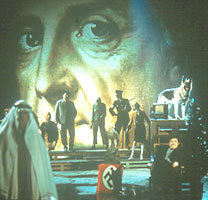|
Representations of the myth
The German film Hitler, a film from Germany, by Hans Jurgen Syberberg, belongs to the New German Cinema genre. Syberberg is aware of the historical myth of Hitler, and he is using this myth to his own advantage. The film is structured as a multi layer montage of sound and visual leitmotifs, and of references to history and film in the form of original documentary and sound material from the 1930s and 1940s. Syberberg takes historical images and makes a theatrical backdrop out of them for his monologues. Since history cannot be accurately reflected in film or any other means, history itself has become a theatre of memories in Syberberg’s film. In one scene, in which Hitler’s personal assistant is confessing, the storytelling is conducted in a theatrical, almost absurd way. Syberberg is using extremely interesting projection techniques. He plays with the meaning of projection both visually and conceptually: Is Hitler a projection of the German people? Has history been projected upon us? Syberberg is using puppets to represent the third Reich leaders in his film. Usage of puppets sends the viewer to the theatrical context; however, I believe that this representation is beyond the scope of the theatrical experience. The historical figures become mannequins of the different uses of society. They have lost their individualism and became actors in the theater of history.
|
|
 |
|